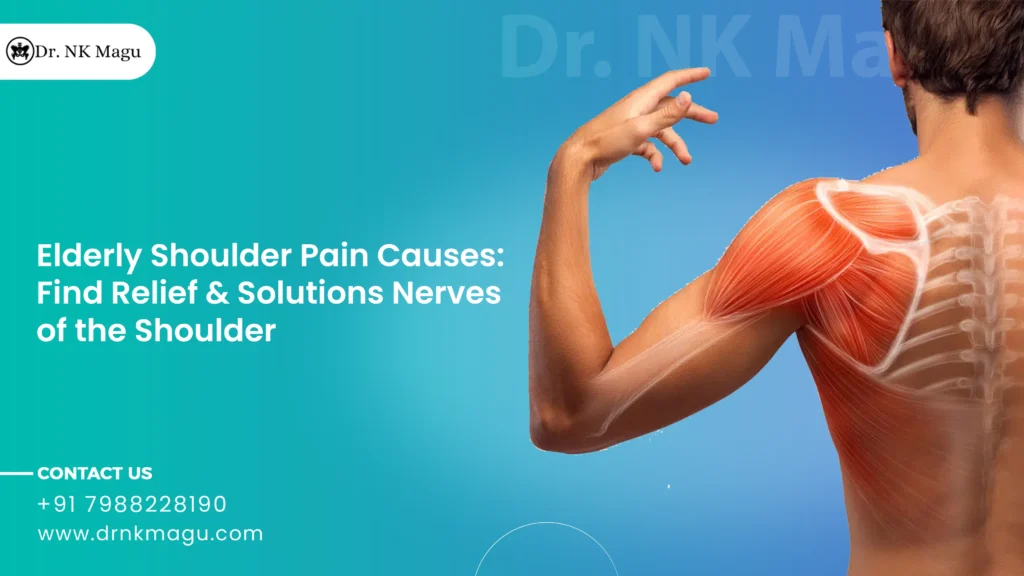Overview
Shoulder pain ranks as the third most common concern, considerably impacting everyday tasks such as lifting, movement, and sleep. It is more prevalent (21%–27%) in older people (45–60 age), but younger and older adolescents can also be affected. The elderly’s shoulder pain is causing difficulties in their quality of life.
The shoulder comprises three bones: the humorous, scapula, and clavicle. It has a ball-and-socket joint, which is responsible for the movement of the shoulder. Tendons, ligaments, and muscles stabilize the shoulder joint to keep it in motion. The most common cause of shoulder pain could be damaged rotator cuffs. As people age, the joints of the elderly patient start getting weaker and thus more prone to injury.
What are the causes of shoulder pain in elders?
There are various types of causes related to elderly shoulder pain.
- Rotator Cuff Tendinitis is a frequent cause of shoulder pain in older adults. It occurs when the tendons of the rotator cuff become inflamed. It can be caused by repetitive stress or prolonged use of the shoulder.
- Shoulder Impingement: Shoulder impingement happens when the top of the shoulder pinches the rotator cuff, causing shoulder pain. It often results from wear and tear, repetitive strain, or changes in posture over time.
- Bursitis: Bursitis involves inflammation of the bursa, a small fluid-filled sac that cushions the shoulder joint. It can be triggered by acute injuries or prolonged pressure that might lead to significant pain.
- Frozen Shoulder (Adhesive Capsulitis): A frozen shoulder condition occurs when the tendons, muscles, and ligaments become stiff. This makes it difficult to move the shoulder and perform daily activities.
- Natural Wear and Tear: As people age, the shoulder joint and rotator cuff tendons can undergo natural wear and tear, which may result in persistent pain.
- Osteoarthritis: Shoulder arthritis involves the degeneration of cartilage in the joint, leading to shoulder pain, stiffness, and reduced mobility. It is mainly related to elderly patients with shoulder joint pain.
- Proximal Humeral Fractures: Fractures of the upper arm bone near the shoulder, often due to falls or trauma, can cause severe pain and significantly impair shoulder function.
Treatment
What are the different types of treatment available for shoulder pain?
There are two main categories of elderly shoulder pain treatment for elderly patients: non-surgical and surgical.
Non-surgical treatment for shoulder pain in elders
- Rest: It is essential for reducing shoulder pain and inflammation, allowing the shoulder to heal.
- Medication: Painkillers can temporarily relieve shoulder pain, helping manage discomfort.
- Occupational Therapy: Occupational therapists design specific activities and exercises to improve shoulder function and alleviate pain.
- Exercise: Gentle exercises are recommended to maintain flexibility and strengthen the shoulder, promoting recovery.
- Hot or Cold Packs: Apply them according to your physician’s advice to manage pain and reduce swelling in the shoulder.
- Steroid injections are given to reduce severe pain and inflammation, providing longer-lasting relief from shoulder pain.
Surgery treatment for shoulder pain
Rotator Cuff Repairs
- Procedure: In open rotator cuff surgery, an incision is made to detach the surrounding muscles and try to repair the rotator cuff directly. Alternatively, Minimally Invasive techniques may also be employed for the surgical treatment of elderly shoulder pain.
- Recovery: Recovery can be prolonged, often requiring a sling or immobilizer to aid healing.
Also Read:- Shoulder Impingement (Rotator Cuff Tendonitis)
Arthroscopy for Impingement Syndrome
- Procedure: This arthroscopic surgery addresses impingement by removing the bursa or part of the acromion to create more space for the rotator cuff.
- Recovery: Recovery can be extensive, particularly if combined with other procedures. The time needed for full recovery may be longer.
Shoulder Replacement
- Procedure: This involves replacing the damaged ball-and-socket joint with an artificial one made of metal and plastic. It is typically recommended for severe joint damage or arthritis.
- Recovery: Recovery can take several months, and patients may need to stay in the hospital for a few days post-surgery to recover from the shoulder pain.
Also Read:- Shoulder Replacement Surgery Cost in India
Arthroscopic SLAP Repair
SLAP stands for superior labrum anterior and posterior.
- Procedure: This surgery repairs a torn superior labrum, restoring it to its proper position and alleviating pain. It is performed using an arthroscope.
- Recovery: The average recovery time is about three months, though it depends on the severity of the tear.
Arthroscopy for Frozen Shoulder
- Procedure: A Bankart repair may be performed to reattach the labrum to the joint capsule, helping to hold the shoulder ball in place. It helps to stabilize the shoulder and treat a frozen shoulder condition.
- Recovery typically spans two to five months, involving at least a month of immobilization and a rehabilitation program focused on strength training.
Prevention from Shoulder Pain
- Maintain good posture.
- Engage in regular exercise.
- Avoid heavy lifting.
- Take frequent breaks while working.
- Consult a professional
Helpful:- Top 10 Orthopedic Surgeons in Gurgaon
A note from Dr. N. K. Magu
Shoulder pain is a significant concern for elderly patients but can often be prevented with proper care. Early intervention and appropriate treatments are crucial for enhancing quality of life. Prioritize your shoulder health and consult a medical professional if you experience any discomfort. You can look at our website for further medical-related consultations in India.
References:













